What Are The Major Threats To Wetland Ecosystems Around The World?

- Draining of wetlands to make space for agriculture or construction work is one of the biggest threats to such areas.
- Like all other habitats, wetlands are also suffering from climate change-induced alterations in the environment.
- Often, wetlands are treated as the dumping grounds where industrial effluents, household wastes or sewage is released.
In simple words, a wetland is an area of land that is saturated with water. Marshes, swamps, bogs, fens, deltas, mudflats, estuaries, etc., all qualify as wetlands. The vegetation found in such wetlands is specifically adapted to survive in the hydric soil of such areas. Wetlands are found in every continent. Some of the largest wetlands are the Sundarbans mangrove forest in the Ganga-Brahmaputra delta, the Amazon River basin, and the Pantanal. Today, wetlands across the world are subjected to many threats. They have been mentioned below:
What Is Causing The Loss Of Wetlands?
Wetlands Are Drained For Agriculture And Construction Activities

Draining of wetlands to make space for agriculture or construction work is one of the biggest threats to such areas. Wetlands are often viewed as wastelands, and no second thought is given prior to draining the land and clearing its vegetation to serve the people’s need and greed. Tourism facilities are also often built by draining wetlands. Such activities destroy the ecosystem and deprive us of the benefits derived from the wetlands.
The Introduction Of Invasive Species Can Damage The Wetland Ecosystem

Like every ecosystem, the existence of species in wetlands also depends on a delicate balance of nature. However, when non-native species introduced by humans invade such ecosystems, it might lead to a misbalance in the existing system. Such species compete with the native ones for natural resources. When one native species start dying off as a result of this competition, the entire food cycle of the ecosystem gets disrupted.
Pollution Is Killing The Flora And Fauna Of Wetlands

Wetlands are regarded as natural water filtration units. The polluted water that washes into wetlands gets purified as it leaves the wetland. The pollutants either sediment out at the bottom of the wetland or are absorbed in the form of nutrients by plants growing in such habitats. However, when the concentration of pollutants cross the saturation level, and more and more toxic contaminants enter the wetlands through water, the species in the area struggle to survive. Often, wetlands are treated as the dumping grounds where industrial effluents, household wastes or sewage is released. High pollution rates in such wetlands kill off the flora and fauna and thus destroy the wetland habitat.
Climate Change Is Destroying Wetland Habitats

Like all other habitats, wetlands are also suffering from climate change-induced alterations in the environment. In places where the temperature increase is raising the sea levels, the coastal wetlands are being submerged or drowned. In other places where higher temperatures are triggering droughts, the wetlands are also drying out. Thus, wetlands are getting lost both due to higher and lower water levels induced by the varying effects of climate change in different parts of the world.
Construction Of Dams Alter The Flow Of Water To Wetlands
The construction of a dam has a great impact on the environment of the place where it is built. Dams alter the natural flow of a river to meet human needs. However, such alterations in the river flow create great disturbances in the ecosystems dependent on the river. Wetland areas like swamps, marshes, etc., might suffer from a lower or a higher flow of water than normal due to the construction of dams. Thus, dams have the power to permanently damage the wetland ecosystems.
Why Do We Need To Protect Wetlands?

Wetlands have a number of beneficial effects on the environment. Coastal wetlands protect the settlements along the coast from storm surges and tidal waves. Wetlands moderate the effects of flooding and help purify water. Such ecosystems are also economically beneficial and are a source of fuelwood, medicinal plants, fish, etc. Thus, given these benefits of wetlands, it is important to protect them from the above-mentioned threats. In many places across the world, the importance of wetland habitats have been recognized and such areas have been granted protection. Exploitation of such ecosystems has been strictly prohibited. However, wetlands in many other places of the world continue to face threats and demand immediate protection.











